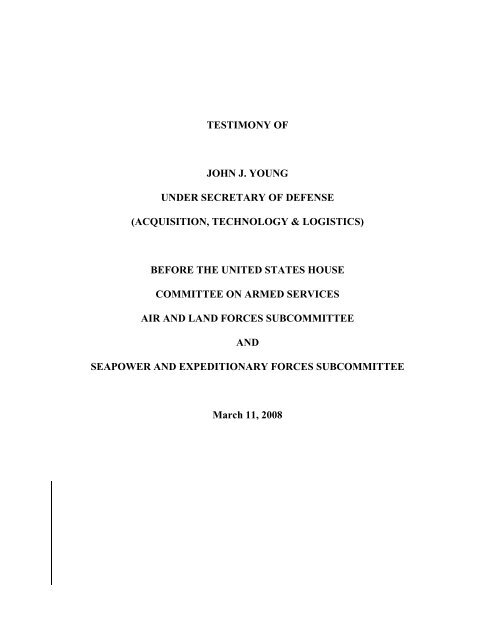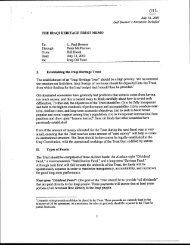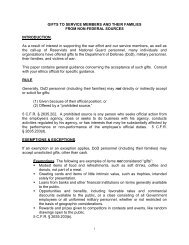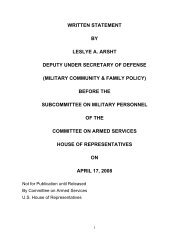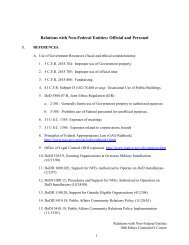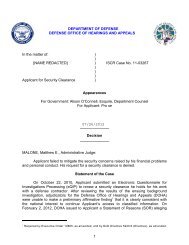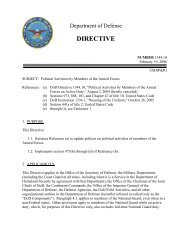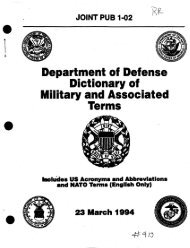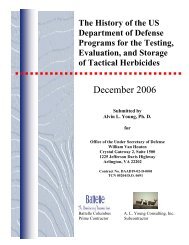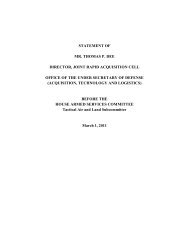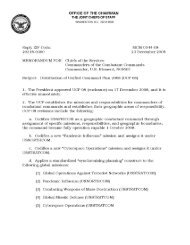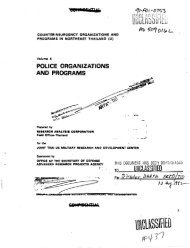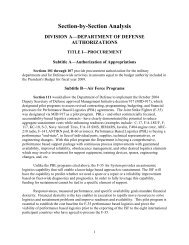testimony of john j. young under secretary of defense (acquisition ...
testimony of john j. young under secretary of defense (acquisition ...
testimony of john j. young under secretary of defense (acquisition ...
Create successful ePaper yourself
Turn your PDF publications into a flip-book with our unique Google optimized e-Paper software.
TESTIMONY OFJOHN J. YOUNGUNDER SECRETARY OF DEFENSE(ACQUISITION, TECHNOLOGY & LOGISTICS)BEFORE THE UNITED STATES HOUSECOMMITTEE ON ARMED SERVICESAIR AND LAND FORCES SUBCOMMITTEEANDSEAPOWER AND EXPEDITIONARY FORCES SUBCOMMITTEEMarch 11, 2008
Mr. Chairmen and distinguished members <strong>of</strong> the Subcommittees, thank youfor the opportunity to appear before you today to discuss the F-22-A Raptor, F-35Lightning II Joint Strike Fighter (JSF), and C-17 programs. My <strong>testimony</strong> todaywill provide background and rationale for the Department’s fiscal year 2009budget request. Specifically, I will address the F-22A program <strong>of</strong> record, the status<strong>of</strong> the F-35 program, the F135 and F136 engine development programs, and theC-17 program <strong>of</strong> record, as requested in your letter <strong>of</strong> February 27, 2008.VisionIn addition to these important programs, I would also like to summarize myvision for Acquisition, Technology and Logistics, which is to drive the capabilityto defeat any adversary on any battlefield. I have focused my approach into fourstrategic thrust areas, each <strong>of</strong> which has a guiding principle, desired outcomes, andspecific initiatives with metrics or steps against which we can measure progress.These four strategic thrust areas are:• Define Effective and Affordable Tools for the Joint Warfighter• Responsibly Spend Every Single Tax Dollar• Take Care <strong>of</strong> Our People• DoD Transformation PrioritiesIn identifying both the problems we face, and the solutions we are seeking, Iam committed to transparency throughout the <strong>acquisition</strong> process. It is my belief2
that we need to be clear, concise, and open with regard to what the Department <strong>of</strong>Defense is seeking and the work it is completing. It is our responsibility asstewards <strong>of</strong> tax dollars to ensure complete openness, fairness, and objectivity in the<strong>acquisition</strong> process. I intend that we will be accountable to ensure the success <strong>of</strong>these initiatives.I have charged the <strong>acquisition</strong> team to create an inspired, high-performingorganization where:• We expect each person must make a difference;• We seek out new ideas and new ways <strong>of</strong> doing business;• We constantly question requirements and how we meet them;• We recognize that we are part <strong>of</strong> a larger neighborhood <strong>of</strong> stakeholdersinterested in successful outcomes at reasonable costs.We live in an increasingly complex world. Our missions vary widely, so weneed strategic resilience and depth; and must ensure our Nation has responseoptions today and for the future with the appropriate capacity and capability toprevail at home and abroad.I would like to highlight some specific initiatives that capture thesephilosophies and are fundamental to transforming the <strong>acquisition</strong> process and3
workforce. They are:1) Program Manager Empowerment and AccountabilityProgram managers play a critical role in developing and fielding weaponsystems. I have put in place a comprehensive strategy to address improving theperformance <strong>of</strong> program managers. Key to this are program manager tenureagreements for ACAT I and II program. My expectation is that tenure agreementsshould correspond to a major milestone and last approximately 4 years. Anotherfundamental piece I have established is Program Management Agreements—acontract between the program manager and the <strong>acquisition</strong> andrequirements/resource <strong>of</strong>ficials—to ensure a common basis for <strong>under</strong>standing andaccountability; that plans are fully resourced and realistically achievable; and thateffective transparent communication takes place throughout the <strong>acquisition</strong>process.2) Configuration Steering Boards (CSBs)I have directed the Military Departments to establish CSBs. My intent is toprovide the program manager a forum for socializing changes that improveaffordability and executability. Boards will be in place for every current and futureACAT I program and will review all requirement changes and any significanttechnical configuration changes which potentially could result in cost and schedulechanges. Boards are empowered to reject any changes and are expected to only4
approve those where the change is deemed critical, funds are identified, andschedule impacts are truly mitigated. I require every <strong>acquisition</strong> team member t<strong>of</strong>ully engage the Planning, Programming, Budgeting, and Execution (PPBE)process thus creating an avenue for program managers to ensure they are funded toexecute their responsibilities or alternately descope their programs to matchreduced budget levels.3) Defense Support Teams (DSTs)To address the challenge <strong>of</strong> <strong>acquisition</strong> execution and assist both industryand DoD program managers, I have expanded the use <strong>of</strong> these teams who are madeup <strong>of</strong> outside world-class technical experts to address our toughest programtechnical issues. I expect the teams to resolve emergent problems and help theDepartment successfully execute tough programs before problems develop.4) Prototyping and CompetitionI have issued policy requiring competitive, technically mature prototyping.My intent is to rectify problems <strong>of</strong> inadequate technology maturity and lack <strong>of</strong><strong>under</strong>standing <strong>of</strong> the critical program development path. Prototyping employed atany level—component, subsystem, system—whatever provides the best value tothe taxpayer.5
to be requested in the FY 2009 supplemental, will provide production lineflexibility. In that context, the Air Force and Department are assessing the timingand costs related to both line shutdown and continued production activities.F-35 ProgramThe F-35 will provide the foundation for the Department’s tactical air forcestructure. The F-35 is an advanced 5 th generation fighter that will replace legacyF-16 and A-10 aircraft for the Air Force, F/A-18 and AV-8 aircraft for the Navyand Marine Corps, as well as replacing numerous legacy aircraft for the eightinternational partners participating in the F-35 program. The F-35 will be moreaffordable, handle more missions, and provide commonality for our Services andcoalition partners. The Department believes that the current program <strong>of</strong> record <strong>of</strong>183 F-22A aircraft will provide an appropriate capability, while enablingprocurement <strong>of</strong> F-35 aircraft in sufficient numbers to ensure affordability,capability, and commonality.The F-35 program is in the seventh year <strong>of</strong> a planned 12-year SystemDevelopment and Demonstration (SDD) phase. All three variants have completedCritical Design Review and are in various stages <strong>of</strong> production. The first flight forthe Conventional Take-Off and Landing (CTOL) variant aircraft occurred inDecember 2006. AA-1 is a non-production representative test aircraft that hascompleted over 30 test flights, providing risk reduction and design and7
manufacturing process confirmation benefits. The Cooperative Avionics Test Bed(CATB) is flying with initial communication, navigation, and interrogation (CNI)suites. Over the next few months the program will continue to integrate additionalCNI capabilities, as well as the radar, sensors, and electronic warfare units that willenable key risk reduction testing prior to actually flying in an F-35. All <strong>of</strong> themission systems sensors, as well as the helmet mounted display, are currentlyflying on other test platforms. The program is approximately 50% complete ontheir s<strong>of</strong>tware development, and all three variants are meeting their KeyPerformance Parameter requirements.In October 2007, I approved a Mid-Course Risk Reduction (MCRR) planthat restored program risk and reserve funding through test plan optimizations andengineering personnel reductions. Specifically, MCRR aimed to exploit theinvestment in integrated labs, flying test beds, and modeling and simulation,allowing a reduction in the number <strong>of</strong> development flight test aircraft required toachieve the SDD objectives from 15 to 13. Additionally, the contractor’sdevelopment-oriented engineering teams are being reduced as the programtransitions into the production phase. The Director, Operational Test andEvaluation (DOT&E) recommended not approving MCRR due to the risksassociated with a reduction in test assets. The Department assessed the risks as8
manageable since LRIP aircraft could be used if test validation and verificationefficiencies were not realized.Manufacturing <strong>of</strong> the test aircraft is taking longer than planned due to lateto-needdesign plans and parts; however, quality is unmatched for a developmentprogram at this stage. The initial Short Take-Off and Vertical Landing (STOVL)aircraft (BF-1) is projected to fly this summer. BF-1 is the first productionrepresentative aircraft. The first production representative CTOL and CarrierVariant (CV) aircraft’s first flights are planned for late in 2009. Seventeen testaircraft are in production with AA-1 flying and BF-1 in ground operations. Lastyear, I approved release <strong>of</strong> the funding for the first two Low Rate Initial Production(LRIP) CTOL aircraft. Later this month, I will convene the Defense AcquisitionBoard (DAB) to review the LRIP 2 award for six CTOL and six STOVL aircraft.The decision on the STOVL aircraft will be delayed until after BF-1 first flight.The F-35 program faces challenges and issues that are not surprising giventhe complexity and size <strong>of</strong> the program. Generally, I am pleased with theprogram’s progress but also realistic that many more challenges lie ahead.Lockheed Martin received their lowest award fee to date in the most recent period.They need to improve their cost and schedule performance, and to recognize thatthey must be ready to forgo a certain level <strong>of</strong> remaining fee to <strong>of</strong>fset cost pressures.The F-35 is important to the U. S. Services, as well as our coalition partners, and I9
am committed to ensuring that we develop a successful program that meets thewarfighters’ requirements.F135 Engine DevelopmentThe Pratt and Whitney (P&W) F135 engine development program is alignedwith the F-35 air vehicle development. The F135 is the primary engine for theprogram and began SDD in 2002. Ten F135 ground test engines and three CTOLand three STOVL flight test engines are in developmental testing and haveaccumulated over 9,000 test hours.In August 2007, an F135 engine experienced a hardware failure during teststand operations with the STOVL lift fan engaged. Root cause analysis determinedthat high cycle fatigue caused the 3 rd stage Low Pressure Turbine (LPT) bladefailure. Test engines were instrumented to assist in verifying the analysis andassist in determining solutions. On February 4, 2008, a similar failure occurredduring test stand operations with the STOVL lift fan engaged. Instrumentation anddata supported the analysis <strong>of</strong> high cycle fatigue in the 3 rd stage. Additionally, theoccurrence confirmed that it was a STOVL powered lift problem experience athigh thrust settings and almost exactly the same vibration regime. The engine wascleared for conventional operations and AA-1 flew a few days later. The exactroot cause appears likely to be a combination <strong>of</strong> factors related to the design <strong>of</strong> theblades, the material composition <strong>of</strong> the blade dampers, and the symmetry <strong>of</strong> the 3 rd10
stage fixed vanes. New blade, blade dampers, and vane hardware are beingretr<strong>of</strong>itted on the test engines and they will begin testing with additionalinstrumentation in April.The engine failure will delay BF-1 first flight by 30-60 days. The originalplan for BF-1 was to fly in the “conventional” mode for several months andgradually phase in STOVL operations and that will not change. Specific STOVLoperations will be delayed approximately 3-4 months and are planned to begin onBF-1 in the December/January timeframe. The schedule delays will not adverselyaffect the program. The F-135 hardware failure is not unique to a developmentalengine program. Many programs experience early test problems that force them toalter the design. That is exactly what happened in this case. The F135 program isprogressing well and I expect that to continue.F136 Engine Development and Alternate Engine StrategyThe General Electric/Rolls Royce (GE/RR) F136 engine lags the F135program by approximately 3-4 years. There are two pre-SDD F136 engines intesting that have accumulated approximately 600 hours. The first F136 SDDengine will begin testing in December 2008. The Department’s Cost AnalysisImprovement Group (CAIG) completed an analysis <strong>of</strong> the F-35 propulsion systemas directed in section 211 <strong>of</strong> the John Warner National Defense Authorization Actfor Fiscal Year 2007. The CAIG determined that there were no life cycle costs11
enefits due to competition, in fact, a competitive program would likely costslightly more. The CAIG also estimated that procurement savings in excess <strong>of</strong>21% would be required to recoup the up front investment in a competitive engineprogram, a savings they deemed unlikely. The CAIG did identify non-quantifiedbenefits to competition. The Department has continually acknowledged the manyintangible benefits <strong>of</strong> competition. The Department did not direct the CAIG toupdate their analysis. There have been no significant changes to the program thatwould have resulted in any changes to their findings.The Department will comply with section 213 <strong>of</strong> the John Warner NationalDefense Authorization Act for FY 2008. We will ensure that in each fiscal yearwhere funds are appropriated there is obligation and expenditure <strong>of</strong> sufficientamounts for continued development and procurement <strong>of</strong> two options for the JSFpropulsion system. However, the Department continues to believe that theinvestment required to develop an alternate engine is more appropriately proposedfor other Department priorities. In the 2006 Quadrennial Defense Review, theDepartment laid out a future strategic vision to meet the new and broader array <strong>of</strong>threats to the Nation. It requires the Department to carefully consider capabilitiesversus cost and, if necessary, divert resources from lower priority programs inorder to be able to afford the new capabilities required.12
Engine technology development, design and manufacturing processimprovements continue to provide increased reliability, maintainability and safety.The F/A-18E/F and F-22A are recent examples <strong>of</strong> aircraft programs thatsuccessfully operate with a single engine provider.Considering Department priorities, budget realities, and improved enginetechnology, the Department concluded that the risk associated with a single enginesource is acceptable and, while it would be nice to have a second engine, it is notnecessary and not affordable.C-17 ProductionBased on the 2005 Mobility Capability Study and Quadrennial DefenseReview, the Department concluded that 180 C-17s, combined with the fleet <strong>of</strong> 112modernized C-5s, provided sufficient strategic airlift capacity to support the<strong>defense</strong> strategy with acceptable risk. The requirement for this level <strong>of</strong> capacitywas recently reexamined during our Nunn-McCurdy review <strong>of</strong> the C-5 ReliabilityEnhancement and Re-engining Program (RERP). Our analysis supported theconclusion that the programmed fleet <strong>of</strong> 189 C-17s, plus 52 re-engined C-5 B/Csand 59 C-5As, also provides sufficient airlift capacity. The Department is nowagain repeating the Mobility Capability Requirements Study, to assess whetheradjustments in the <strong>defense</strong> strategy may have altered the Department’s airliftneeds. It is not clear that substantial changes have occurred in DoD’s need for13
oversized and outsized cargo capacity demand for strategic airlifters, and theDepartment believes that the C-17 production line should not be kept open. Othergeneral cargo capacity demand adjustments can be substantially addressed by therecent selection <strong>of</strong> a capable KC-45 tanker by the Air Force.I again thank the two Subcommittees for their time in allowing me to presentthe Department’s positions on these important programs as well as my vision for<strong>acquisition</strong>, technology and logistics.14


